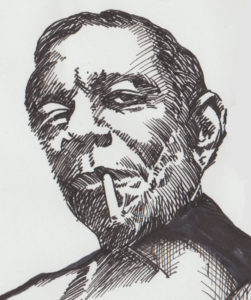
 Alice Walker was born in Eatonton, Georgia and as well as being African-American, her family has Cherokee, Scottish and Irish lineage. After high school, Walker attended Spelman College in Atlanta, Georgia and graduated in 1965 from Sarah Lawrence College in Yonkers, New York. During her junior year, she spent a summer as an exchange student in Uganda.
Alice Walker was born in Eatonton, Georgia and as well as being African-American, her family has Cherokee, Scottish and Irish lineage. After high school, Walker attended Spelman College in Atlanta, Georgia and graduated in 1965 from Sarah Lawrence College in Yonkers, New York. During her junior year, she spent a summer as an exchange student in Uganda.
She was married to activist Mel Leventhal from 1967 to 1976, the couple had one daughter, Rebecca Walker (also a prominent activist and writer).
Walker’s writings include novels, stories, essays and poems.
Topically, they focus on the struggles of African Americans, particularly women, and they witness against societies that are racist, sexist and violent. Her writings also focus on the role of women of colour in culture and history. Walker is a respected figure in the liberal political community for her support of unconventional and unpopular views as a matter of principle. She is an open bisexual, and sympathetic of people of all sexualities, ethnicities, and races. Her first book of poetry was written while she was still a senior at Sarah Lawrence. She took a brief sabbatical from writing when she and Leventhal lived in Mississippi and worked in the U.S. Civil Rights Movement.
Walker resumed her writing career when she joined Ms Magazine. An article she published in 1975 was largely responsible for the renewal of interest in the work of Zora Neale Hurston. In 1973, Walker and fellow Hurston scholar Charlotte D. Hunt discovered Hurston’s unmarked grave in Ft. Pierce, FL. Both women paid for a modest headstone for the gravesite.
In addition to her collected short stories and poetry, Walker’s first work of fiction, The Third Life of Grange Copeland, was published in 1970.In 1976, Walker’s second novel, “Meridian”, was published. The novel dealt with activist workers in the South during the civil rights movement, and closely paralleled some of Walker’s own experiences
In 1982, Walker would publish what has become her best-known work, the novel “The Color Purple”. The story of a young black woman fighting her way through not only racist white culture but patriarchal black culture was a resounding commercial success, and the immediacy of the characters and the story struck a nerve in readers, regardless of race, age, or gender. The book became a best seller and was subsequently made into a 1985 movie as well as a 2005 Broadway musical play.
 Champion Jack Dupree, was an American Blues pianist. He was the embodiment of the New Orleans Blues and Boogie Woogie pianist and a true Barrelhouse “professor”. His father was from the Belgian Congo and his mother was African American and Cherokee. By the time he was one, both parents had died in a fire started by the Ku Klux Klan.
Champion Jack Dupree, was an American Blues pianist. He was the embodiment of the New Orleans Blues and Boogie Woogie pianist and a true Barrelhouse “professor”. His father was from the Belgian Congo and his mother was African American and Cherokee. By the time he was one, both parents had died in a fire started by the Ku Klux Klan.
He was orphaned, had an unusually tough childhood and was raised at the Colored Waifs home, famously associated with Louis Armstrong where he stayed till he was 14, by which time he had sung for coins on street corners, learned to gamble and had been introduced to the piano by an elderly Italian priest.
By the age of 20 then, the two traditional roads away from poverty, sport and music, were Dupree’s life. Some time in this period he witnessed the random killing of a black man by white thugs. With little love for the South and hoping to pursue one of those careers the young man headed for Chicago. The year was 1930. In Detroit he met Joe Louis , who encouraged him to become a boxer. He ultimately fought in 107 bouts and winning Golden Gloves and other championships, a nickname Champion Jack, which he used the rest of his life.
War saw Dupree a cook in the Marines and for two years a Japanese POW.
In 1958 he recorded his masterpiece, the album Blues from the Gutter. Too raw for 1950s white America, although a few years later it would have been perfect for the new blues enthusiasts
Absence of financial success, however, was only part of the reason why 1959 found Dupree in London. Dupree explained that his reasons for quitting America were exactly the same as those that black intellectuals and jazz artists, of that era and before, typically expressed.
White American Racism drove him first North and then overseas. In Europe he found status as a musician and respect as a man.
Dupree was an active anti-racist. His 1968 blues tribute to Martin Luther King directly addressed his white audiences. “I know you’re white and free but what is to become of me”.
His European recordings have a topical feel and America’s loss was Europe’s gain. There was an eventual brief homecoming, with success at festivals in Chicago and the city of his birth, but he returned to Germany where he died on January 21st 1992 of cancer and, it is said, with a smile on his face
 Queen Philippa
Queen Philippa
England’s first black queen, mother of the black prince, Philippa was the daughter of William of Hainault, a lord in part of what is now Belgium. When she was nine the King of England, Edward II, decided that he would marry his son, the future Edward III, to her, and sent one of his bishops, a Bishop Stapeldon, to look at her. He described her thus: “The lady whom we saw has not uncomely hair, betwixt blue-black and brown. Her head is cleaned shaped; her forehead high and broad, and standing somewhat forward. Her face narrows between the eyes, and the lower part of her face is still more narrow and slender than the forehead. Her eyes are blackish brown and deep. Her nose is fairly smooth and even, save that is somewhat broad at the tip and flattened, yet it is no snub nose. Her nostrils are also broad, her mouth fairly wide. Her lips somewhat full and especially the lower lip…all her limbs are well set and unmaimed, and nought is amiss so far as a man may see. Moreover, she is brown of skin all over, and much like her father and in all things she is pleasant enough, as it seems to us.”
Four years later Prince Edward went to visit his bride-to-be and her family and fell in love with her. She was betrothed to him and in 1327, when she was only 14, she arrived in England. The next year, when she was 15, they married and were crowned King and Queen in 1330 when she was heavily pregnant with her first child and only 17.
This first child was called Edward, like his father, but is better known as the Black Prince. Many say that he was called this because of the colour of his armour, but there are records that show that he was called ‘black’ when he was very small. The French called him ‘Le Noir’.
Philippa was a remarkable woman. She was very wise and was known and loved by the English for her kindliness and restraint. She would travel with her husband on his campaigns and take her children as well. When the King was abroad, she ruled in his absence. Queen’s College in Oxford University was founded under her direction by her chaplain, Robert de Eglesfield in 1341 when she was 28. She brought many artists and scholars from Hainault who contributed to English culture.
When she died, Edward never really recovered, and she was much mourned by him and the country. King Edward had a beautiful sculpture made for her tomb which you can see today at Westminster Abbey. Phillipa of Hainault led an extraordinary life as a queen. She was quite intelligent about economics and single-handedly realized that much more could be done with the English wool that was being produced out of Norwich. She used part of her dowry to set up factories in Norwich to produce finished cloth, which was worth much more than ordinary wool. A monk later wrote about her, “Blessed be the name and memory of Queen Phillipa, who first invented English clothes.” Phillipa also founded the other key industry of England, the coal operations at Tyndale. Phillipa was quite a warrior, too. In 1346, when her husband was too busy, she managed to stop an invasion of the Scottish and even capture their King. Phillipa was role model for all English women and girls who showed their adoration for her by carrying daggers and wearing hats shaped like helmets
Samuel Coleridge-Taylor was born in Holborn, London, to a Sierra Leonean Creole father, Daniel Peter Hughes Taylor, and an English mother, Alice Hare Martin on the 15th August, 1875. He was named after the poet Samuel Taylor-Coleridge. The hyphen in his surname was initially a typographical error, which he then adopted for his professional name. Shortly after Samuel’s birth his father was appointed coroner for the British Empire in the Gambia and returned to West Africa. Samuel was raised by Alice and her adopted parents in Croydon. At school he was abused as other children setting fire to his tightly curled hair and he sought refuge in music. Alice saw that he was becoming skilful on the violin and sent him for tuition at the Royal College of Music. In his second term, he composed two anthems that were published by Novellos. He later taught and conducted the orchestra at the Croydon Conservetoire.
In 1899 he married a fellow student of his at the Royal College Of Music, Jessie Walmisley, despite her parents’ objection to his half-black parentage. He soon earned a reputation as a composer, helped by Sir Edward Elgar who recommended him to the Three Choirs Festival that premiered his “Ballade in A Minor”. His successes brought him a tour of America in 1904, which in turn increased his interest in his racial heritage.
Coleridge-Taylor was greatly admired by African Americans and in 1901, a 200-voice African-American chorus was founded in Washington, DC called the Samuel Coleridge-Taylor Society.
He visited the USA three times receiving great acclaim and earned the title “the Black Mahler.”
He attempted to do “for African music what Brahms did for Hungarian music and Dvorak for Bohemian music” and began to weave African elements into his musical tapestries. This wasn’t acceptable in some circles and the musical hierarchy cruelly used the “N” word to describe him and his African based rhythms were criticised in the Musical Times as ‘barbaric’.
He met the black American poet Paul Laurence Dunbar and set some of his poems to music and was also influenced by him to be aware of his African ancestry and the music of that continent.
The composer credited the Fisk Jubilee Singers and their European tours with introducing him to African American spirituals. He also collected traditional songs of Africans and African Americans from other sources for the work which became his 24 Negro Melodies, Op. 59.Coleridge-Taylor was greatly admired by African Americans and in 1901, a 200-voice African-American chorus was founded in Washington, DC called the Samuel Coleridge-Taylor Society. He visited the USA three times receiving great acclaim and earned the title “the Black Mahler.”
In America Coleridge-Taylor’s music and work inspired the establishment of the Coleridge-Taylor Choral Society. This was a choral society in Washington, DC composed of some 200 African American singers for the purpose of performing Coleridge-Taylor’s works. This society sponsored Samuel Coleridge-Taylor’s first visit to the United States where he conducted them in a concert at Constitution Hall.
Coleridge-Taylor’s work and his visits to the United States were very important cultural and social connections. The impact of his work and his person is further witnessed by his association with two prominent African-Americans, Booker T. Washington and W.E.B. DuBois. Coleridge-Taylor was received at the White House by President Theodore Roosevelt, an extremely rare happening in such times. The great esteem by which Coleridge-Taylor’s life and work was held by African Americans is evidenced even today by two American schools bearing his name: in Louisville, Kentucky, The Samuel Coleridge-Taylor Elementary School and in Baltimore, Maryland, The Samuel Coleridge-Taylor Elementary School established in 1926. Gentle as he was in manner, refined as was his calling, he was still a fierce apostle of human liberty and a crusader for the rights of man. He was a parable for the black consciousness of our present time. Coleridge-Taylor was very generous, especially to black people down on their luck, and gave away far too much money, bearing in mind that composers were not handsomely paid for their efforts and often sold the rights to works outright, thereby missing out on royalties which went to publishers instead. He was much sought after for lecturing and adjudicating at festivals.
In November 1898, Hiawatha’s Wedding Feast was placed between Rossini’s Barber of Seville Overture and Beethoven’s 5th symphony at a concert at the Royal College Of Music. The Times called it ‘clever’ and the Guardian ‘effective’ but such was the buzz about this exciting young composer that six towns booked the cantata before its first note was publicly sung. Within months it was being performed around the English-speaking world, as far away as New Zealand.
Almost from the moment of success, though, he was beset by money worries, by now, having to feed a family of four. He took on a professorship at Trinity College, as well as much private teaching and choral conducting but because of his family’s needs he was overworked to the point of collapse.
One summer’s morning in 1912, at the age of 37 Samuel Coleridge-Taylor left home and walked to West Croydon railway station, where he bought a ticket to Crystal Palace. Before the train arrived, he collapsed on the platform.
He staggered home unaided to St Leonard’s Road where his doctor diagnosed pneumonia and prescribed rest. Although he was confined to his bed he worked on a manuscript for a violin concerto but died four days later.
At the funeral the crowds lined the route four deep, there to honour Samuel Coleridge-Taylor, the first black composer to make an impact on English ears. His cantata, Hiawatha’s Wedding Feast, a setting of Longfellow’s epic poem, drew mass attendances on both sides of the Atlantic and remained popular for well over half a century, seasonally packing the Royal Albert Hall. Of his other 80-odd opus numbers, two Hiawatha sequels fell flat and the orchestral parts of the violin concerto he was working on at the time of his death was rumoured to have been lost on the Titanic.
His wife was left penniless and a charity concert raised £1440. King George V awarded her a Civil List Pension of £100 and Novello’s came under pressure from the Society of Authors to share its Hiawatha bonanza.
It emerged that the publishers had paid the young composer 15 guineas (£15.75) for the cantata, which earned the company a fortune.
His Three Impromptus, Op 78 was included in a 2006 benefit concert after Hurricane Katrina had devastated the City of New Orleans and his influence can be heard in black musicians such as Duke Ellington, Donny Hathaway, Don Shirley and Bernie Worrell but his life and music has had a more far-reaching effect on the world of music.
Because of Novello’s refusal to grant his widow a fair royalty in 1914 the Performing Rights Society was formed which has given fair dues to composers in Britain ever since.
